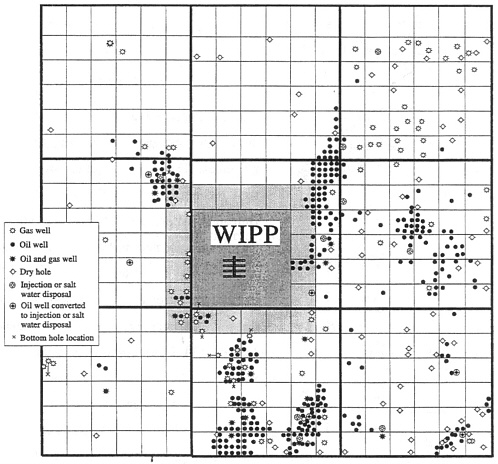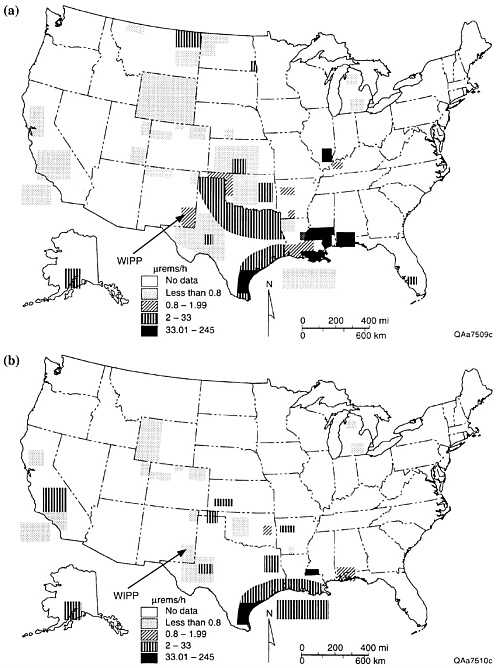Baseline Radiogenic Analysis of Subsurface Fluids
In this section the committee provides recommendations on research activities to enhance confidence in the long-term performance of WIPP. In particular, the committee considered how “baseline” studies undertaken during the early phases of repository operation could be used to support future efforts to assess repository performance.
Finding: There has been extensive monitoring of radioactivity in the air, soils, fluvial sediments, surface water, and shallow groundwater in the area surrounding WIPP.3 However, the committee has determined that radiological baseline information is not available for subsurface brines and hydrocarbons near the WIPP site. This baseline information is important for environmental monitoring in the operational and post-operational phases of WIPP.
Recommendation: The committee recommends that DOE should develop and implement a plan to sample oil-field brines, petroleum, and solids associated with current hydrocarbon production to assess the magnitude and variability of naturally occurring radioactive material (NORM) in the vicinity of the WIPP site. Samples should be collected and analyzed for the radionuclides that will be present in transuranic waste emplaced at WIPP and the radionuclides common in NORM. These samples should be archived to permit subsequent analysis for constituents that may be of interest in the future.4,5 The committee recommends that a
|
3 |
See, for example, Conley (1999); DOE (1997c); Herczeg et al. (1988); and Kenney et al. (1999). Additionally, previous Environmental Evaluation Group studies on radiation monitoring of air, surface soil, and biota samples near the WIPP site include Neill et al. (1998); Kenney et al. (1990, 1995, 1998); Kenney and Ballard (1990); and Kenney (1991, 1992, 1994). Ramey (1985) summarizes U.S. Geological Survey data on simple radiological characterization (i.e., gross alpha, gross beta, dissolved radium, and dissolved uranium) of fluids in the Rustler Formation. References to other studies are contained in annual reports of the Carlsbad Environmental Monitoring Research Center (CEMRC, 1999) and on the CEMRC website, http://www.cemrc.org. |
|
4 |
A reanalysis of a sample using a different detection method could yield a different value. These detection limitations should be understood and distinguished from true natural differences in background radiation. |
sampling plan be implemented prior to the closure of any underground rooms in WIPP that contain TRU waste.
Rationale: Early studies discounted the potential for hydrocarbon production in the vicinity of WIPP, but over the past 20 years this way of thinking has changed dramatically. The site is now surrounded by wells (see Figure 2) for hydrocarbon production (Broadhead et al., 1995), and drilling activities continue. Furthermore, it is relatively common for brines associated with hydrocarbons to be radiogenic (Bloch and Key, 1981; Fisher, 1995). Oil-field brines in the Delaware Basin share this property (Fisher, 1995). The information available on oil-field brines and petroleum resources generally consists of gross radiation measurements (i.e., gross activity), rather than analytical data on the radionuclide constituents. Such analytical data on the radioactivity of oil-field brines and petroleum resources at the WIPP site have not been made available to the committee and may not exist.
If, during or after WIPP operations, increased radioactivity in the vicinity of WIPP is observed, is this the result of a failure of the WIPP to contain its waste, or is it due to NORM? This question cannot be answered easily unless the oil-field brines, petroleum, and solids associated with hydrocarbon production (e.g., suspended solids, precipitated scale, sludges, and formation fragments) are analyzed for their naturally occurring radiation. Analyses for radioactivity and radionuclides will be necessary if disputes arise about potential releases of radionuclides from the repository. An example of the need to obtain adequate NORM background data already has been observed with occurrences of natural surface contamination on the exterior of truck transportation packages while en route to WIPP during the first three months of operation.
“Human intrusion scenarios” involving hydrocarbon exploration and production are now considered processes through which radionuclides might be released from WIPP (Kirkes, 1998). If brines have a measurable NORM content, then human intrusion that results in brine flow through WIPP to the surface is a means by which radioactivity could be carried to the surface that is not due to the TRU waste emplaced in WIPP. If oil-field brine NORM is present, then it is conceivable that NORM releases would be greater than releases from the TRU waste contents of WIPP, even if drilling breaches the repository.
Transport and disposal of oil-field brines that have high NORM contents are also potential mechanisms for localized increases in radiation. Any such increases in radiation in the vicinity of WIPP cannot necessarily be attributed to WIPP operations or the failure of WIPP to contain its waste.
There are data suggesting that oil-field brines near WIPP might contain NORM. Otto (1989, reproduced in Fisher, 1995; see Figure 3)
|
5 |
The archiving of monitoring data, as well as samples, is also a long-term challenge due to the evolution of information technology and the changes in state-of-the-art storage media that will likely take place over the three decades in which WIPP is projected to be open and operational. Any data records not in paper form would be subject to such challenges. |

FIGURE 2 Petroleum wells in the vicinity of the WIPP site. See Figure 1 for an inset map showing the WIPP site's approximate location within New Mexico. SOURCE: Silva (1996, p. 24).

FIGURE 3 Regions of high activity from NORM in the United States from (a) oil-producing facilities and (b) gas-producing facilities. Values are aggregated median differences over background. The legend shows various shadings corresponding to various ranges of dose rates measured in microrems per hour (µrem/h). These dose rates are radioactivity measuremerits of NORM deposits in piping and in fluids brought to the surface. These measurements describe the concentration of radioactive species, a characteristic of the NORM deposits at any locality that is not directly dependent on the local production rate (of hydrocarbons or brine) or on the amounts of fluid that were extracted to produce the deposits. SOURCE: Fisher (1995), after Otto (1989).
shows the Delaware Basin of southeast New Mexico as a region of NORM activity in oil-and gas-producing facilities. Fisher states that “(1) not every major oil or gas field has associated high NORM levels, and (2) no major hydrocarbon-producing basin in Texas is exempt from high levels of radioactivity.” The major hydrocarbon-producing basins in Texas described by Fisher include the Delaware Basin, which contain producing formations near the WIPP site, and the adjacent Central Basin Platform (Hill, 1996, p. 26).
In response to committee requests for information, DOE has answered that no data have been collected on “naturally occurring radionuclides in the underground brines and hydrocarbons near WIPP by DOE. In addition, DOE is unaware of any related information collected by the oil and gas industry” (Mewhinney, 1998b).
The need for these data is clear—no effective monitoring of the WIPP area can be successful without understanding potential sources of radiation in the environment. Air, soils, sediments, ground and surface waters, biota, and people have been analyzed to provide a database (e.g., through CEMRC activities). NORM from local hydrocarbon operations must also be analyzed. The NORM data will
-
identify sources of future contamination events that might (wrongly) be attributed to a failure of WIPP;
-
place any radioactivity releases from human intrusion scenarios (e.g., from petroleum exploration and production) in perspective; and
-
improve the monitoring efforts.
The committee recommends near-term action to collect and analyze these data based on an appropriate sampling plan. The plan must include frequency of sampling and analyses; radionuclides to be analyzed; collection of data to assess NORM radioactivity and to estimate its variability; sampling, analysis, and archiving protocols; and producing formations to be tested. These formations should include both past (if applicable) and present producing zones, new producing zones as they become exploited in the future, and formations from which brine is (or likely will be) extracted.
Samples could come from ongoing well-based operations that generate separator streams of oil, gas, and water. These separators and separator streams are owned by the operators of the leases. The drilling of new wells would be justified if data from separator streams prove to be inadequate.
The radionuclides of interest include both those that contribute to the site's NORM background radioactivity and those in the DOE TRU inventory destined for WIPP. The NORM activity may include contributions from potassium-40, isotopes of uranium and thorium, and daughter products such as isotopes of radium. Radionuclides in TRU waste include isotopes of uranium and TRU elements and, in remote-handled6 TRU
|
6 |
Remote-handled waste is classified as that with a surface dose rate greater than or equal to 200 mrem per hour. Such waste contains fission products and activation products such as cobalt-60, strontium-90, yttrium-90, ruthenium-106, cesium-137, barium-137, and europium-152. These and other radioisotopes emit penetrating beta and gamma radiation that requires shielding. |
waste, fission and activation products. Since some TRU inventory radionuclides are not commonly found in nature, sampling to determine whether such radionuclides are present in the environment may be a good way to distinguish radioactivity due to NORM from that due to TRU waste.
For the reasons given above, the committee supports the collection of NORM data on deep subsurface fluids, even though the isotopic signatures of NORM and TRU waste radioactivity are expected to differ and therefore to be readily distinguishable. In the committee's view, DOE would be better served to possess these NORM data prior to any reported discovery of significant radioactivity in the region; hence, in its recommendation the committee proposes that this survey to sample deep subsurface fluids be conducted in the near term. This survey need not continue once the measurement objectives, as proposed in this recommendation, have been met.






